Sometimes
ya just gotta
take it.
Sometimes
ya just gotta
take it.



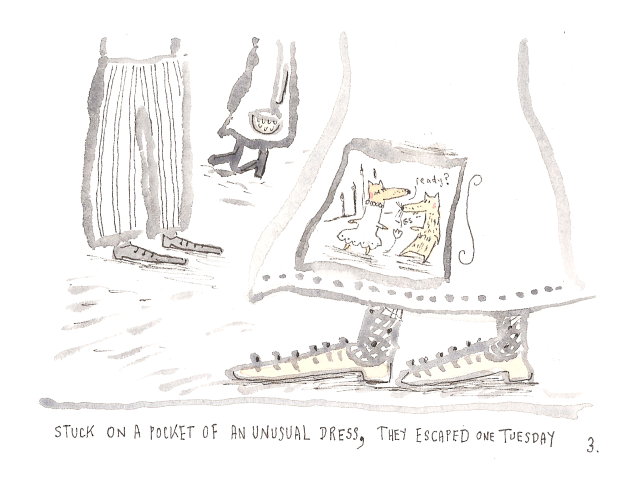



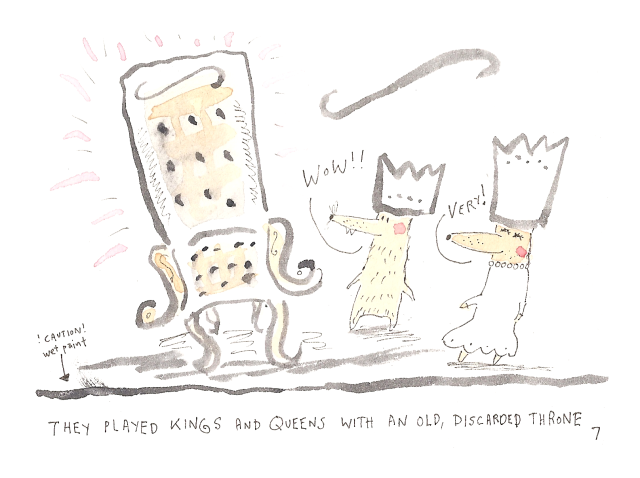

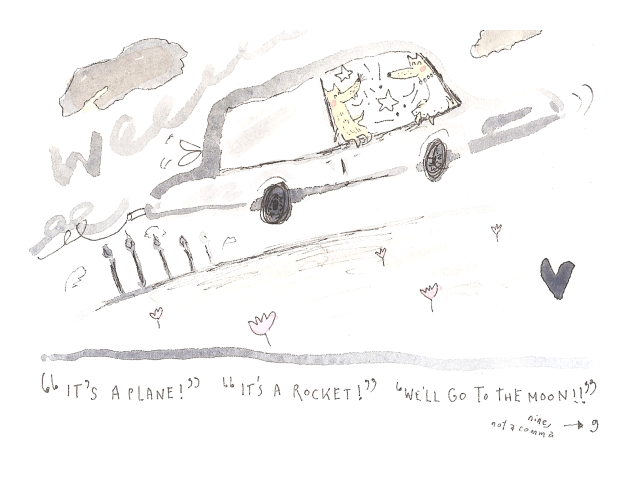


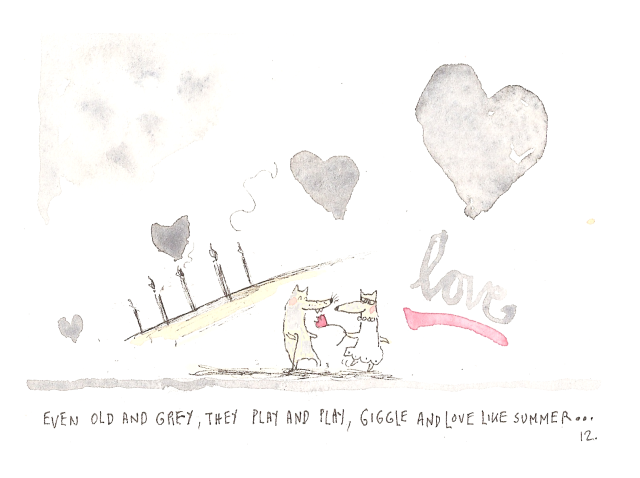





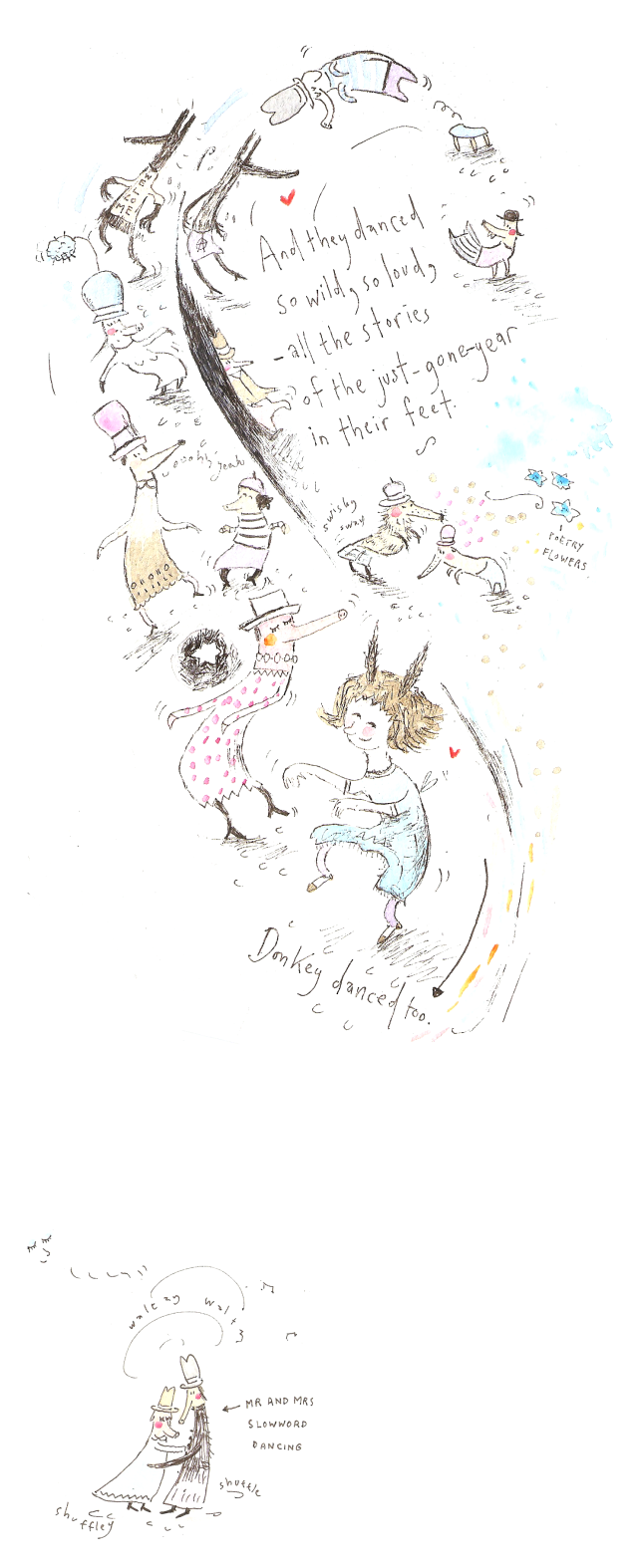
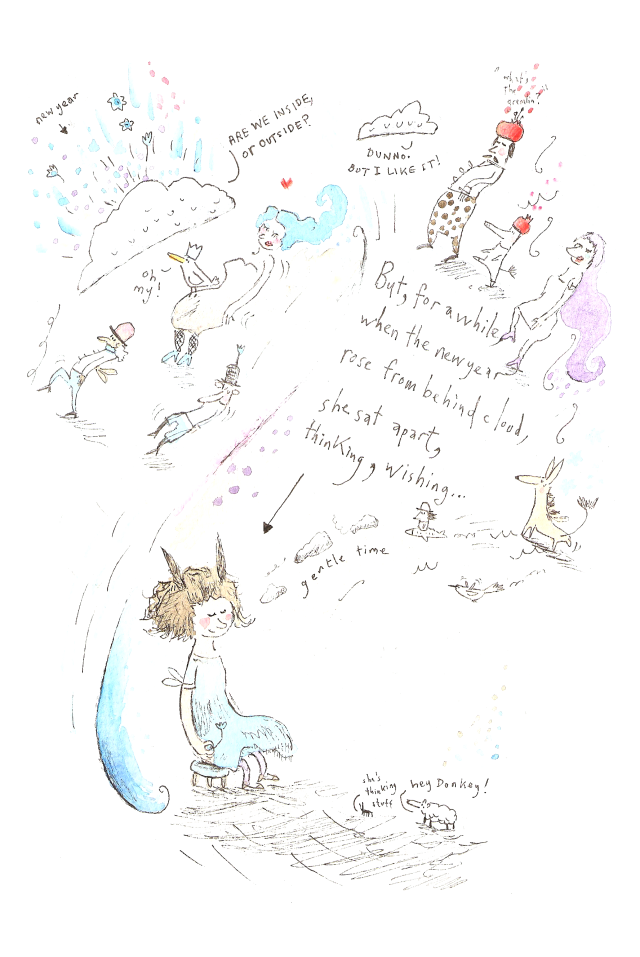
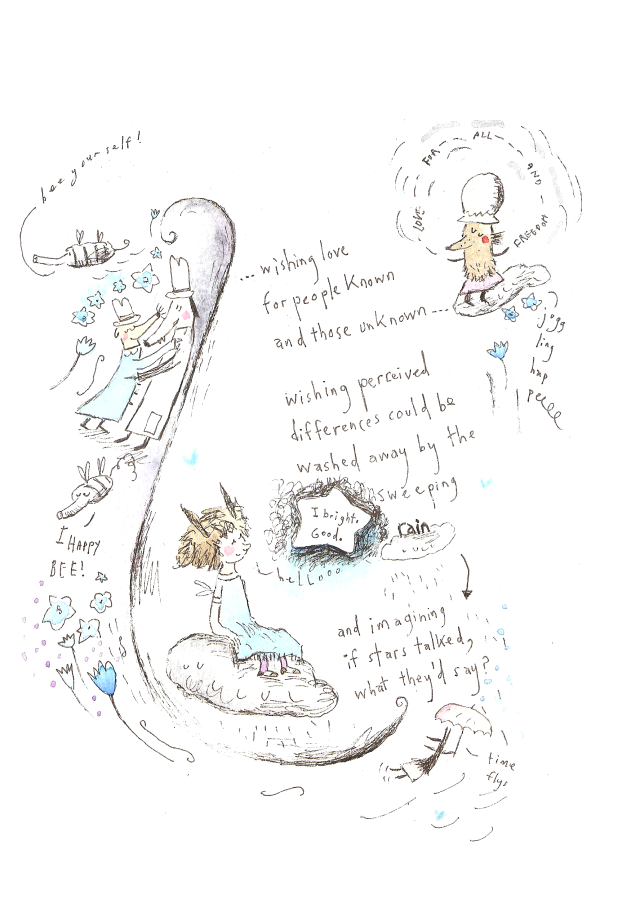
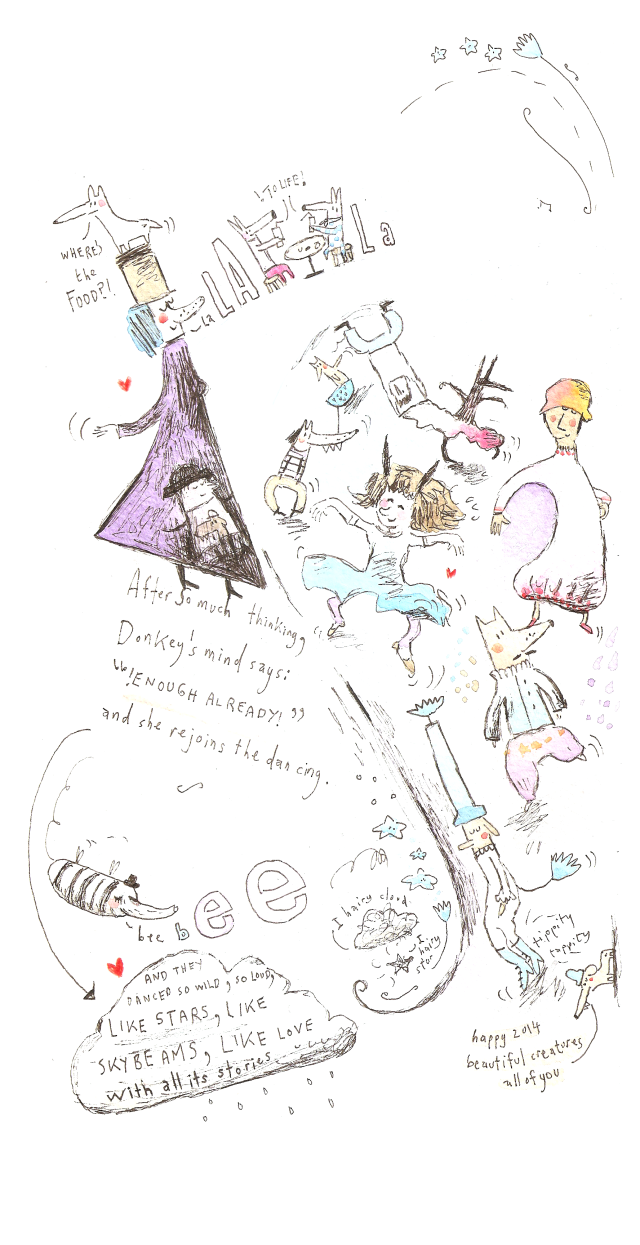

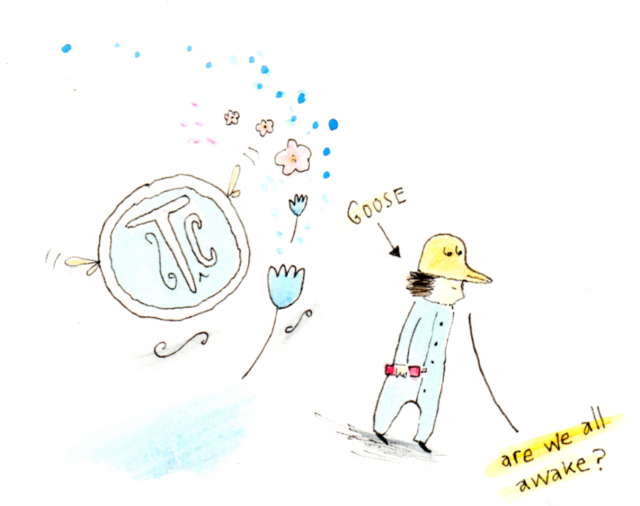
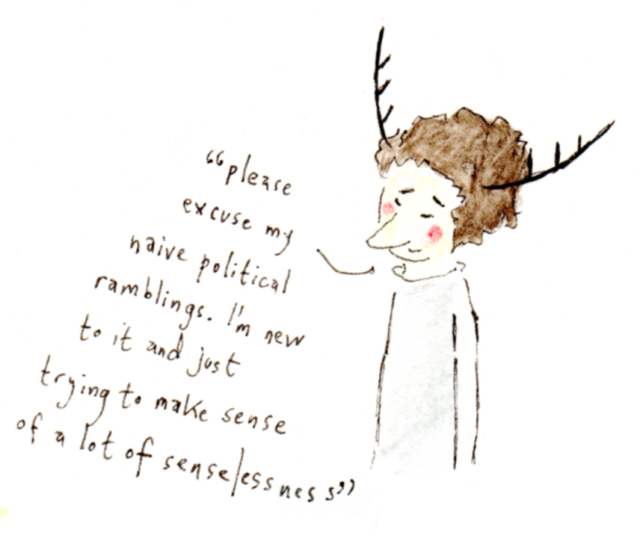



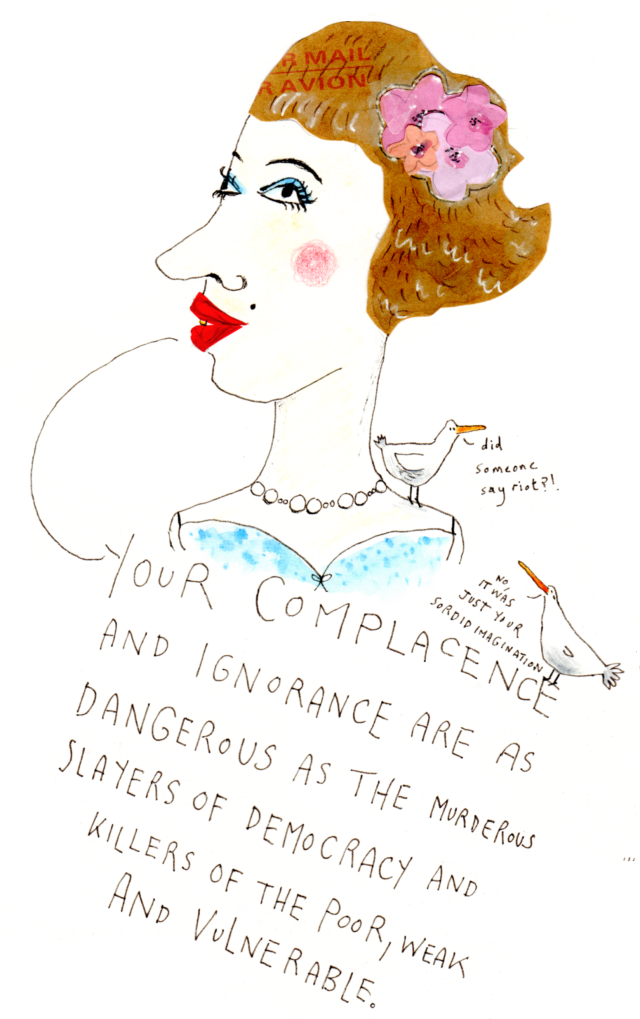

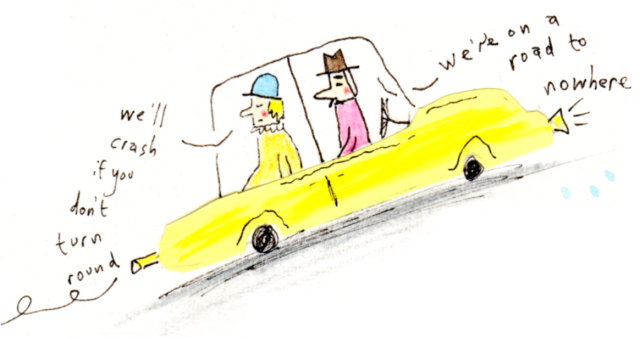











The last couple of weeks on the blog have really reminded me how books can take you everywhere and anywhere. From “pink” books, to the Holocaust, to environmental campaigning, I do love the journey my blog takes me on.
 Today’s roving brings us to contemplate engineering and what constitutes failure, with Rosie Revere, Engineer by Andrea Beaty, illustrated by David Roberts, a follow up to this same team’s ingenious Iggy Peck, Architect.
Today’s roving brings us to contemplate engineering and what constitutes failure, with Rosie Revere, Engineer by Andrea Beaty, illustrated by David Roberts, a follow up to this same team’s ingenious Iggy Peck, Architect.
Rosie dreams of being an engineer. She loves collecting rubbish and creating contraptions. But people laugh at her creations and her emerging confidence is soon crushed. When Great Great Aunt Rose tells young Rosie how she built aeroplanes during the war, Rosie is once again inspired. But will Rosie’s engineering work this time? What if her plans fail?
An upbeat rhyming tale about the value of trying and trying again, Rosie Revere, Engineer encourages readers to hold on to their passions, and to never give up, even if things don’t work out the first time. Great for encouraging a can-do approach to whatever life throws at you, Rosie’s tale also leads naturally into discussions about women’s roles during the Second World War, and women who have broken the mould in various fields, notably that of flight.
 Rosie is creative, thoughtful, passionate, full of a sense of fun, and with more than a nod to Rosie the Riveter, not least with her matching headscarf, and the slogan “We Can Do It” on her flying machine.
Rosie is creative, thoughtful, passionate, full of a sense of fun, and with more than a nod to Rosie the Riveter, not least with her matching headscarf, and the slogan “We Can Do It” on her flying machine.
Roberts’ illustrations are a scrapheap challenge (junkyard ward) junkie’s dream come true. Littered with curious details to pore over (can you spot a Wild Thing, or follow the unwritten story of the baby bird?) the colours are bright and pen drawings clear. Often on expanses of white, Roberts’ work is vibrant, crisp and fresh, perfectly matching the confident and purposeful message at the heart of the book.

There is a decidedly American flavour to the text (some rhymes, I assume, work better with certain US accents than my UK one, and cheese spray may seem rather mind boggling to many on this side of the pond) so a little contextualisation might be handy, but my young engineers didn’t bat an eyelid at this. They were simply delighted by this Rosie and her take on life. Spunky, funky and full of fun and inspiration, three cheers for Rosie Revere!
To go alongside reading Rosie Revere, Engineer I set up a little after-school structural engineering project involving essential tools of the trade: tooth picks and sweets.

The aim of the game was to see what we could build and how we could build it using just these two materials, plus some imagination, and a little bit of concentration…

Space rockets and climbing frames soon rose from the kitchen table.

A spider’s web of construction emerged, with lots of experimental investigation as to what made our feats of engineering stand strong.

We also got to explore the roles of different materials, as we quickly discovered that most dolly mixtures aren’t very good for this type of project, whilst mini wine gums and gum drops are excellent. (If you want to go for just one, the wine gums are a better bet as they are less messy; the gum drops litter the kitchen table with sugar sprinkles, and also make fingers stickier).

We all thoroughly enjoyed this engineering project, and M is very keen to try it again soon to model chemical compound structure (her idea!); different sweets for different elements? Definitely sounds fun to me.
Whilst designing, engineering and building we listened to some brilliant music:
Other activities which would be great fun to get up to alongside reading Rosie Revere, Engineer include:
Don’t miss the teacher’s guide to Rosie Revere either.
What are you going to engineer today?
Disclosure: I recieved a free reivew copy of Rosie Revere, Engineer from the publishers.
Today I’ve something completely different for you.
Given the age of my kids I tend to review picture books, chapter books and nonfiction aimed at the under 10 crowd. But over the summer I read a YA novel that took my breath away; and this is no trope, for I finished it gulping for air, both sobbing and full of not-exactly-joy but certainly a passion for life.
I simply couldn’t not share it with you. I want to share the very best of books with you, and this is one of those. Whilst I’m sure it will win awards, I’m even more confident that it will change the shape of your heart and what you see around you.
 The book that will do this is Rose Under Fire by Elizabeth Wein.
The book that will do this is Rose Under Fire by Elizabeth Wein.
Starkly put, Rose Under Fire is about life in Ravensbrück concentration camp during the Second World War.
It’s about the Air Transport Auxiliary (ATA) of the British Royal Air Force and the women who played a part in it. It’s about the “Rabbits”, 86 women on whom brutal medical experiments were conducted without consent, whilst prisoners in Ravensbrück. Its about some of the themes and characters of an earlier (and also excellent, award winning) novel by Wein, Code Name Verity, exploring their lives later in the war. It’s a riveting, deeply moving book, and one of the questions it raises is about how to bear witness to the Holocaust.
I felt the best way I could do that right now, was to interview Wein.
Playing by the book: Rose Under Fire tells a (fictional) account of an American civilian’s experience of her time in Ravensbrück concentration camp towards the end of the Second World War. It is beautiful, sensitive, and brimming with passion, love, hope. It is also utterly harrowing to read. I don’t think I stopped sobbing for the last 100 pages. What on earth was it like to write? (In the afterword you share one instance where you did cry, but the experience of reading it is so emotionally draining – and in equal measure emotionally uplifting – that I can’t believe researching and writing it was any easier on the heart.)
Elizabeth Wein: While I was writing it I kept torturing myself with my inability to tell this story — not only because I can’t possibly experience what these people experienced, but also because of my cowardice in being unable to come close to it. Could I live on a couple of pieces of bread and a bowl of broth every day for a week? I could, but I didn’t. Could I stand outside without a coat in the freezing rain for an hour or two? I could, but I didn’t. I was scared to do it: scared of cold, scared of hunger. And it felt wrong to try, since whatever I did to try to get into their shoes, I wasn’t going to be in their shoes.
And then, there were things that I couldn’t bring myself to write. I baulked at describing how they used cadavers to make the roll calls come out right. For some reason this seemed like my limit — the boundary I couldn’t cross. And then I crossed it anyway because if I don’t tell it, who’s going to know?
Playing by the book: Did you have to lock yourself away? Did you lead parallel lives for the duration, whilst writing? Did you find yourself like Rose becoming immune on some level to the horror?
Elizabeth Wein: Often, I used gaps in Rose’s memory to account for details I didn’t want to have to describe. Rose describes herself as becoming immune to the horror, but it’s probably more accurate to say you get used to it. I’ve discovered that my “immunity” is very specifically related to Ravensbrück itself. I have a heightened familiarity with that particular camp, and I’m fortified against anything I find out that happened there. But when I hear about the atrocities that happened at other camps, places I’m less familiar with, a whole new level of horror hits me. It’s like the inmates of Ravensbrück struggling to understand the rumours coming out of Auschwitz — impossible to comprehend unless you’ve seen it for yourself.
I dreamed a lot about Ravensbrück while I was writing Rose Under Fire, and I never dream about my books. Never. Curiously, in most of my dreams I was visiting, either as an onlooker or at a memorial site in the present day. Sometimes I was being treated as a prisoner, but it was always a simulation—never the real thing.
Playing by the book: Given the emotional intensity of the book I wondered if you have been able to read it since it was published – to revisit it. In the novel, two prisoners from Ravensbruck explore so thoughtfully how difficult it is for them to revisit their experiences (in the context of considering being witnesses at war crime trials after the war is over) and I wondered if you had experienced something like it with your own bearing witness.
Elizabeth Wein: One of my fears is that I’m going to be asked to read Rose’s poems in public and that, like her, I’m not going to be able to do this.
There are some things I can’t talk about. But I can’t write about them either, so yes, I guess I am like my made-up characters in the limits to which I can bear witness. An example is mothers and children in the camps. I managed to write about the cadavers, but not about mothers protecting and losing their children. I know a lot of things I can’t talk about. I guess that’s what makes me feel instinctively that some prisoners might have trouble following through with the promise to “Tell the world.”
Playing by the book: My response to your book got me thinking about “ownership” of stories about the holocaust. Part of me felt guilt for enjoying so very much a book that was only possible because real people suffered, died in the most awful of circumstances. But then I felt that perhaps it is ok for me to feel so connected to Rose’s story because it is about humankind (and the worst of humanity) and we need such stories to feel vital and relevant to us in the hope that it prevents anything like it happening again (and to remind us of the goodness, kindness, beauty all around in everyday life). As the writer of the story how did you feel about ownership? And about the relationship between “truth” and imagined stories?
Elizabeth Wein: This is so true, and so hard, and I talked about it a little in my answer to your question about what it was like to write the book. I really did feel, a lot of the time, that this was not my story to tell. But if I don’t tell it, who is going to any more? The books by the few survivors who tell their own stories are dated and out of print—and not necessarily accessible even when it’s possible to get hold of them. Several of my main sources I had to read in French. So I am telling it as far as I am able. But I don’t own this story. It belongs to the real people who lived it. I am just passing it on — a similar role to Rose’s.
As far as truth is concerned, I tried very hard not to misrepresent anything or sensationalize anything that happened within the context of Ravensbrück. There may be errors, but most of the incidents I’ve described are based on survivor accounts. I guess the difficulty is that the reader doesn’t know how much to believe. I don’t know how to remedy that in fiction — I mean, after all, for all my good intentions, it is a work of fiction.
It never occurred to me to feel guilty about anyone “enjoying” the read, though! The whole time I was writing it I kept thinking, “WHO is going to want to read this? NOBODY is going to want to read this!”
It’s true. I’m rather astonished, and delighted, to find that people are connecting with it so deeply.
Playing by the book: Ownership in another sense intrigued me; you state in the acknowledgements that your editorial team was “much more actively involved” in the creation of Rose Under Fire. Can you share a little more about this, and about how this different sort of genesis for a story felt for you as a writer
Elizabeth Wein: Well, mainly this was because I was operating under a deadline. I’ve written work-for-hire novels before to a deadline, but never a full-length book of my own creation, and that meant that I delivered a manuscript which I considered less than perfect. As a result, I was given more editorial direction in polishing the rough draft than I’ve ever had before.
I’d say that the structure of the novel changed a little as a result, but not the fabric of it. We removed some extraneous scenes and characters. But perhaps the most remarkable aspect of the work was that I had three editors working on this at the same time – Stella Paskins at Egmont in the UK, Catherine Onder at Disney Hyperion in the USA, and Janice Weaver at Doubleday in Canada— and they all had to be consulted and they all had to agree on any changes that I made.
It was actually Stella who came up with the title. All four of us, and my agent Ginger Clark as well, had been emailing back and forth for weeks trying out different combinations of stressful descriptive situations involving the name Rose! We all agreed, from the start, that Rose’s name should be part of the title. My working title was simply “Rose’s Book.”
I was reluctant to give up my control over the timing of the manuscript, but I really did need guidance on the revision, and was grateful for it.
Playing by the book: As part of the research for this novel you visited Ravensbruck. What it the place like today? What still exists? And what did it feel like to be there? Are any of the “Rabbits” (the name given to the women who were experimented on in Ravensbruck, and who play a major role in Rose Under Fire) still alive?
Elizabeth Wein: After the war Ravensbrück ended up deep inside East Germany, and for fifty years it was used as a Soviet Army base. So it had an active and complex history for a long time after it ceased to be a concentration camp. Under the Soviet administration a memorial site was dedicated there in 1959, so the buildings that were part of that project were preserved (essentially, the prison block). The SS barracks outside the camp walls were all used as Soviet officers’ quarters so they are all still standing and are in good shape. They are now part of the current museum and memorial site and also house a youth hostel.
A few of the factory buildings and the walls are still there, but none of the barracks remain standing. The main part of the camp has been cleared and the surface is spread with black cinders, to replicate the memorable ground cover at the time of the camp. Depressions in the ground mark where the barracks stood. Trees that were planted when the camp was first built have now matured, so the effect is that of an open plaza or park.
The administration building where new prisoners were processed no longer stands, but the red-tiled floor of the shower room has been preserved because the initial dehumanizing process of being made to strip, shower, then get your head shaved and be issued with prison clothes was a hugely traumatic experience for most prisoners and made a lasting impression on them. Even those who had been in prison for months before arriving at Ravensbrück found this process shocking.
For me, it was amazing to be at Ravensbrück. I had been so mentally invested in this place for so long (two years) before I finally got to see it. I think in some sense it must be a pale reflection of what a survivor would feel travelling back for a memorial ceremony—it obviously isn’t the place you knew, and yet you recognize it. I knew my way around. I actually ended up giving tours to some of the other people attending the summer school we were enrolled in, because most of them were there for the seminar and not because of the location, so I knew considerably more about the camp than my colleagues.
I wrote a couple of blog entries, including photographs, while I was there:
“Post from Ravensbrück”
“One More from Ravensbrück”
I believe a few of the “Rabbits” are still alive, but I’m not sure which ones. I’ve been constructed a sort of memorial page on my website, with photographs and links to their biographies. I’m about half way through and so far I haven’t been able to confirm those who are still living, but many of them did live long and productive lives after the end of the war.
I believe Wanda Połtawska, the author of And I Am Afraid of My Dreams, is still alive. The heroic Girl Scout Wacława Andrzejak may also still be living.
Playing by the book: And talking of research for your novel, you hold a pilot’s licence and clearly love flying – your knowledge and passion shine through in both Rose Under Fire and Code Name Verity. As someone who doesn’t fly can you describe what it is like to pilot a plane?
Elizabeth Wein: Hahahahaha! That’s not really a question I can answer in a paragraph or two!
I think that what you really take away after a couple of lessons is that it’s actually just a mechanical skill, like driving, which you have to practise and practise until a lot of it becomes automatic. Maybe some people find it intuitive, but not me. You’re not soaring free in the sky like a bird on the wing: you’re checking your oil pressure, making time and distance and wind speed calculations, making sure the engine and radio are set correctly, etc. etc. Learning to fly is the hardest thing I’ve ever done. The initial payback is a sense of satisfaction in doing a difficult job well (hopefully), and only then can you look around you and enjoy the beauty of the open sky. I try hard to get this across to my readers, too — it’s something you have to work at and take very seriously, but it really does open up wonders to you.
Playing by the book: What sort of plane do you normally fly? Of the planes you haven’t flown, what sort of plane would you like to fly?
Elizabeth Wein: I did all my training in a Cessna 152, which is a pretty standard training aircraft. Lately I’ve started flying a Piper Warrior, also known as a PA-28, which is a little bigger than a 152 (it seats 4 instead of 2!) and has low wings rather than high wings. They’re both single-engine planes. I am pretty short and find the Warrior is more comfortable for me to see out of!
Of course I dream of some day being able to try my hand at flying a Spitfire. I think every pilot does. But on a more realistic level, I’d really like to learn to fly a floatplane. I did get one lesson in one once. I have this dream where I become an expert seaplane pilot and own a little plane of my own and fly it around Scotland landing on lochs and staying at remote Victorian hotels.
Playing by the book: I understand that you are now working on a book set in Ethiopia in the run up to World War 2. Can you share a few more details? And do you have any hopes or plans to return to Maddie or Rose or any other character from Code Name Verity or Rose Under Fire in the future?
Elizabeth Wein: The new book is set during the Italian invasion of Ethiopia in 1935, but its focus is on the transplanted American family who finds themselves caught up in it. There are a brother and a sister who learn to fly. I don’t really want to say more because I’m still in the middle of writing it and things are bound to change!
I do have an idea for a book set in the “next generation” of the Code Name Verity world, taking place in the early 1970s, which might feature some characters from CNV or ROSE. I guess what I should emphasize is that in my head, their stories continue before and after the events that take place in the novels. Maddie, I feel, is still alive today. My daughter and a friend and I were discussing a scenario where an elderly Maddie and Jamie are flying to France in the present day, on a scheduled commercial flight, and make a stink in security. Maddie: “I remember flying to France with no lights and 500 pounds of plastic explosive in the back and nobody made me take my shoes off!” Jamie: “You dinnae want to see my feet. I lost my toes in the North Sea.”
Playing by the book: Ah Elizabeth, yes! And how lovely to end the interview with laughter. Thank you. Thank you for your books, for your bearing witness, and – through your writing – for making me feel like I can be a better person than I am.
Elizabeth Wein’s website: http://www.elizabethwein.com/
Elizabeth Wein’s blog: http://eegatland.livejournal.com/
Elizabeth Wein on Twitter: @EWein2412
Elizabeth Wein’s keynote speech at the Federation of Children’s Book Groups’ Conference 2013.
Thanks to Chalet Fan, whose review of Rose Under Fire made me drop everything and head straight to the bookshop.
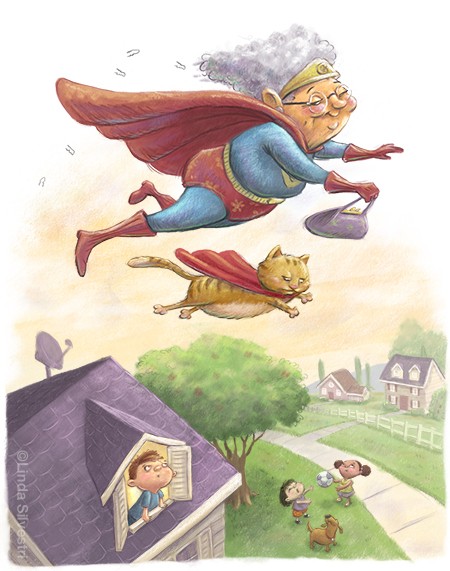 Granny/Superhero hybrid. For Illustration Friday.
Granny/Superhero hybrid. For Illustration Friday.
…………………………………………………………………………………………………
Finally peeking my groggy head up after a bit of time underground, building a new portfolio. Squeaked by just in time for the SCBWI L.A. Summer conference, from which I just returned.
I’d love to share some of the inspiration and new focus with y’all, once my head ceases to spin, that is!
It’s great to be back in the blogging seat!


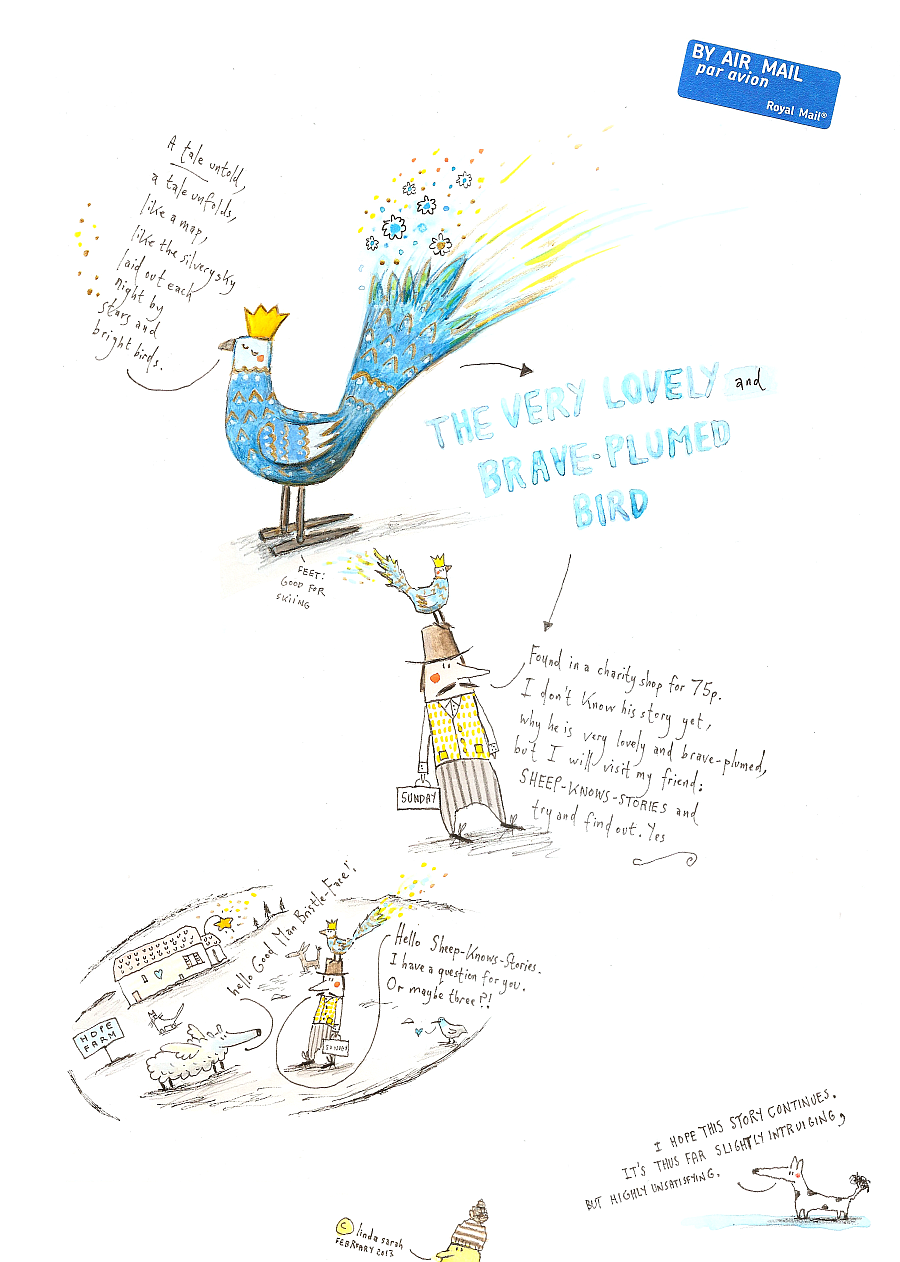
I haven’t been posting lately – I got unwell last year and have been in hospital a couple of times, but getting stronger day by day – yay!
One of my publishers just asked me to make a bio – she said I could draw it if it was easier…so here’s the result!
Wishing you all a beautiful 2013, full of good bits, sparkly bits, romantic bits, playful bits, fighting-for-those-who-need-someone-in-their-corner bits and tons and tons of giggly bits. Oh, and a huge hug and love too, linda xx
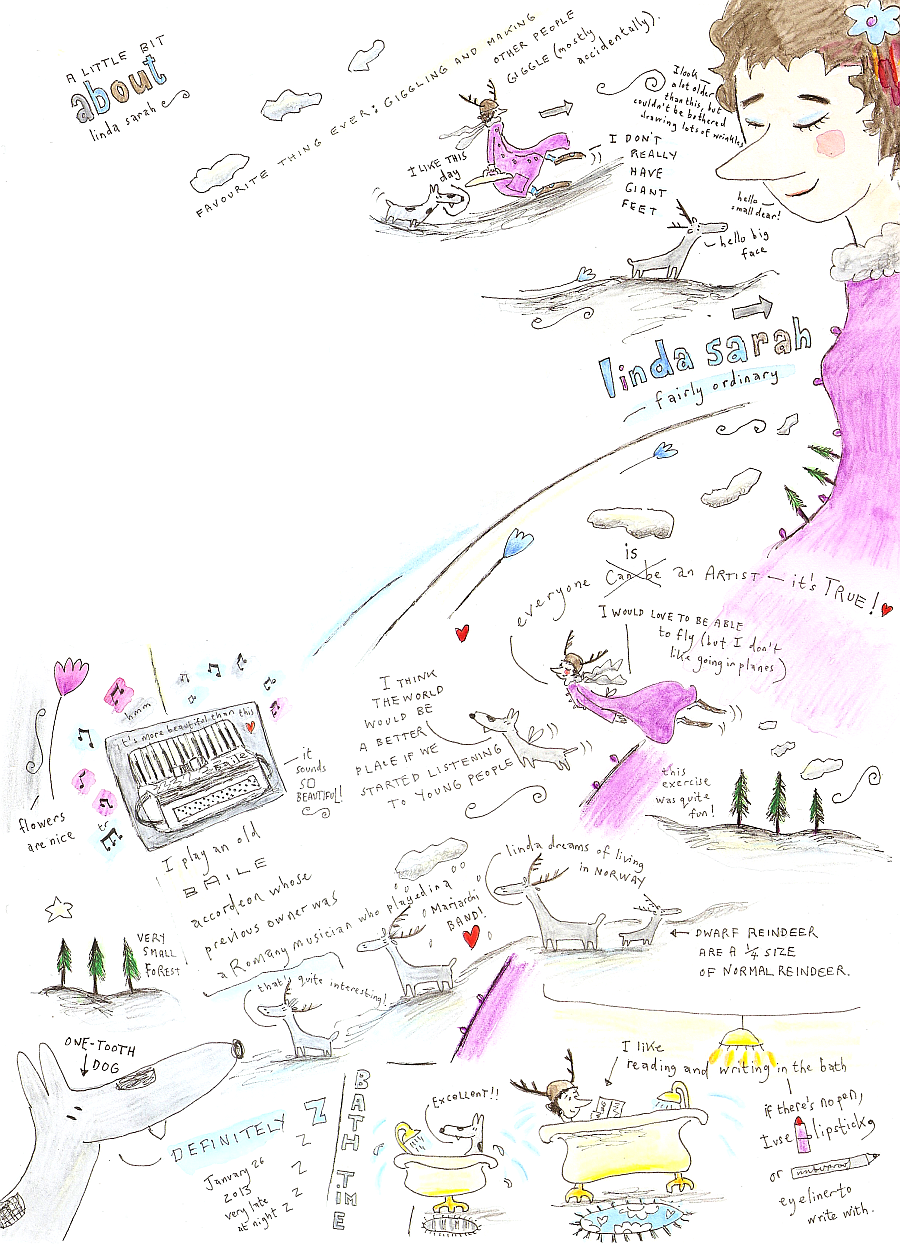
4 Stars Chase Danger, Super Spy: Pirates of Pineapple Island Chase & Lisa Olivera Adam Goodman 32 Pages: Ages: 4 to 7 ................... From Website: 7-year-old super-spies Chase Danger and Princess Ali Bali must think fast when they discover pirates have stolen Zalezgon’s magical pineapples. But that’s not all! Ali’s little brother Aiden has been [...]![]()
Once you’ve finished a book what do you do with it? Shelve it away so it can barely be seen?
How about, instead, exhibiting it on a window sill or mantelpiece to invite comment, to become an ever present part of your life?
Not all books lend themselves to this of course, but High Times: A History of Aviation by Golden Cosmos, and Swan Lake by Ping Zhu are not your everyday sort of book.
An almost wordless, non-fiction accordion book, High Times: A History of Aviation takes you on a journey from Icarus via Leonardo da Vinci, to the Wright Brothers, through the Second World War on to Concorde and the Space Shuttle. Key dates and inventions are picked out and briefly explained in the book’s wrap-around cover, which acts as a key for details to spot in the exciting and broad landscape presented as the book opens out.

Ping Zhu’s Swan Lake, which takes the same format, is entirely wordless. One side of the book shows the audience watching a performance of the ballet, whilst on the reverse you can see behind the scenes as the ballerinas prepare themselves to go on stage.

Both books are wonderfully tactile to hold and interact with. Printed on heavy-weight card these are books you really want to feel between your fingers.

Swan Lake‘s illustrations reminded me of 1960s illustrations, and the girls really enjoyed exploring the audience and making up stories about the different characters they could see, from the bored looking lady with a pearl necklace to the rather mysterious animals who have somehow snuck in to the theatre (they made me think of a Finnish illustrator I like, Hannamari Ruohonen, who also creates fabulous wordless picture books).
The printing technique and bold colour scheme of High Times ensures the book feels both retro and modern. Again, there is lots of fun to be had looking for details, from the family going on holiday with their rubber duck, to the zoo animal being transported by Boeing 747. This book is a great example of how science (in this case, engineering and inventions) can also be explored through art. Team it up with The Fabulous Flying Machines of Alberto Santos-Dumont by Victoria Griffith, illustrated by Eva Montanari (which I reviewed here) and The Story of Inventions, by Anna Claybourne, illustrated by Adam Larkum (which I reviewed here) and you’ve got a terrific trio of books to inspire the next generation of flying machine inventors.
But these books are not just for the young. Both NoBrow books are immensely stylish, and as such, will no doubt appeal to adults as well as children. I can easily imagine them unfolded and on display in beautiful, architect designed houses. And why not?
Displaying stories and illustration on your walls is great way to integrate books into your lives, and at £10 a pop I can’t think of a cheaper way to get some eye catching, discussion-inducing art up on your walls.
Inspired by the idea of displaying an illustrated story, the girls set about making their own “mural book”. I blu-tacked a length of fax paper (yes, such a thing still exists, I got mine from Rymans) up our staircase and the girls took turns to illustrate a story chinese-whisper style.

M would illustrate a stretch of paper, then J would take over the story and add her twists and turns. Because I was nervous about pen marks going on the wall I illustrated a simple border along the length of the paper and explained that the girls had to draw inside the border. This worked really well and The HWA (Humane Wall Association) can confirm “No walls were harmed during the making of this book”.

The story grew and grew…
The narrative was somewhat complex, with lots of free association going on, but some of my favourite cameos were these:

“Zeus sent down thunderbolts onto the dinosaurs escaping by bicycle.”

“The dragon and the unicorn came to the magic castle.”
The girls’ mural book is still up on the wall and it’s the first thing anyone sees when we open our front door. I rather like how a story welcomes people into our home.
Whilst we were all illustrating we listened to
Other activities which could be fun to get up to alongside reading High Times: A History of Aviation or Swan Lake include:
What books have you enjoyed recently that are gorgeous enough for you to want to display them as art?
Disclosure: I received free copies of High Times: A History of Aviation by Golden Cosmos, and Swan Lake by Ping Zhu from NoBrow Press. I was under no obligation to review the books and I received no money for this post.
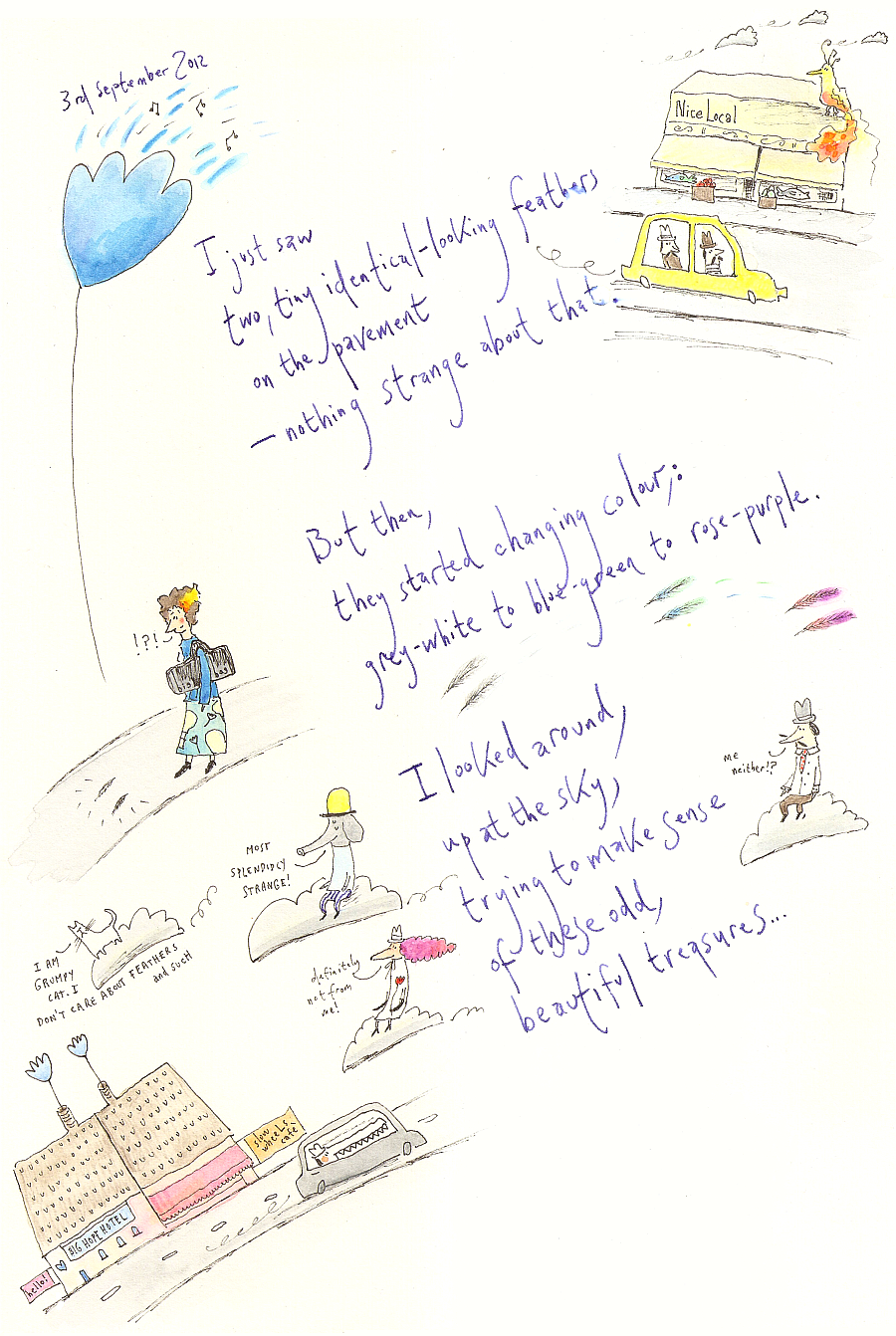





















I love to fly, but I very rarely enjoy reading books about flying, especially while in an airplane: all too often they tend involve words like “plummet”, “screaming”, “disaster” and “splatted”. Nothing like reading a sentence that combines all four and then spending a few tense hours at several thousand feet listening to every change in engine pitch and staring out the windows trying to work out if the wing normally wobbles that much.
Books that should never appear in airport booksellers (that I have actually see stocked) include all the various “air crash investigations” series, any of the 4 books I have seen with “air disaster” in their title and – of course - Alive, the infamous story of 16 blokes crashed in the Andes eating the unthinkable, which will not only put you off flying but right off your inflight meal.
I deally in-flight books should be diverting enough to distract you from the plane, not remind you you’re on one. So you would imagine that reading Qf32: The Captain’s Extraordinary Account Of How One Of The World’s Worst Air Disasters Was Averted by Qantas pilot Richard De Crespigny would be right out.
deally in-flight books should be diverting enough to distract you from the plane, not remind you you’re on one. So you would imagine that reading Qf32: The Captain’s Extraordinary Account Of How One Of The World’s Worst Air Disasters Was Averted by Qantas pilot Richard De Crespigny would be right out.
But as near-disaster stories go, it’s a very reassuring one, and this is down in no small measure to the calm and clear explanations of what does happen onboard when things start to go badly wrong. And Richard should know. He was the captain on what should have been a routine long-haul flight from Singapore to Sydney, piloting one of Qantas’s new A380 aircraft. It should have been a routine flight but shortly after leaving Changi Airport, an explosion shattered engine 2, sending hundreds of pieces of shrapnel ripping through the wing and fuselage, and creating chaos as vital flight systems and back-ups were damaged or destroyed.
The flight, with nearly 500 people on board, had the potential to be one of history’s worst aviation disasters. Some advance reports even stated that the plane had crashed but the experienced flight crew, led by De Crespigny, managed to land and safely disembark their passengers after hours of nerve-wracking effort.
The book doesn’t just shed light on what happened on that flight. It follows Richard’s life and career, from his time with the RAAF through over 20 years and Qantas, and explains the skills and training of a top-level airline pilot. Richard clearly loves to fly and is confident in the air, but he’s sympathetic to those of us who aren’t, as he explained in an interview with Escape’s Doc Holiday.
I have and will always be sympathetic to nervous flyers; this is why the QF32 crew behaved the way they did, informing and debriefing the passengers. I can’t emphasise enough that the crew have extraordinary skills and are trained to look after you in the case of an emergency. Whatever the emergency, the pilots and crew in the good airlines have been trained for every contingency and you are in the best hands! They know what they are doing. They have been trained, they are knowledgeable and they will not panic.
And is he confident that training is backed up by
Add a Comment
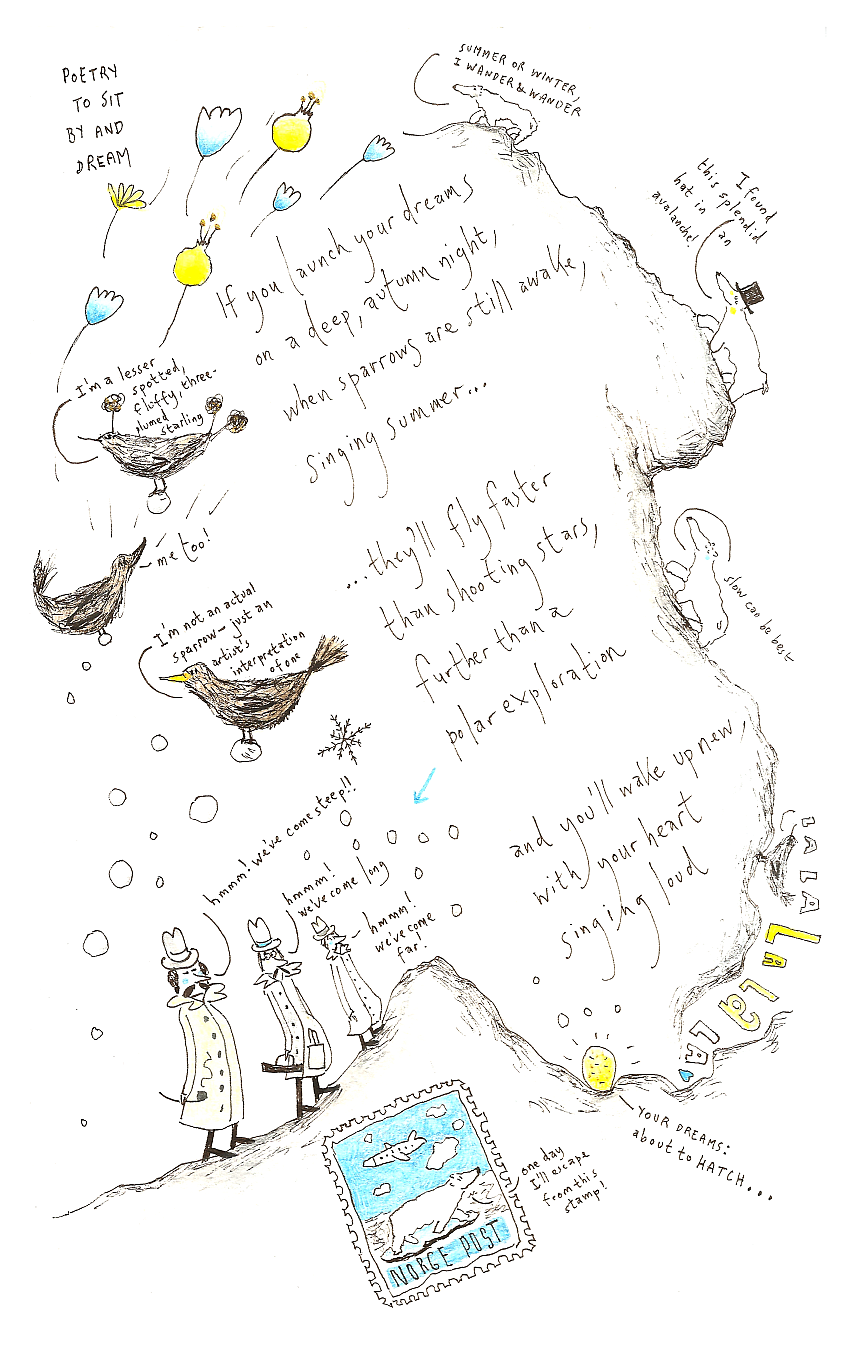
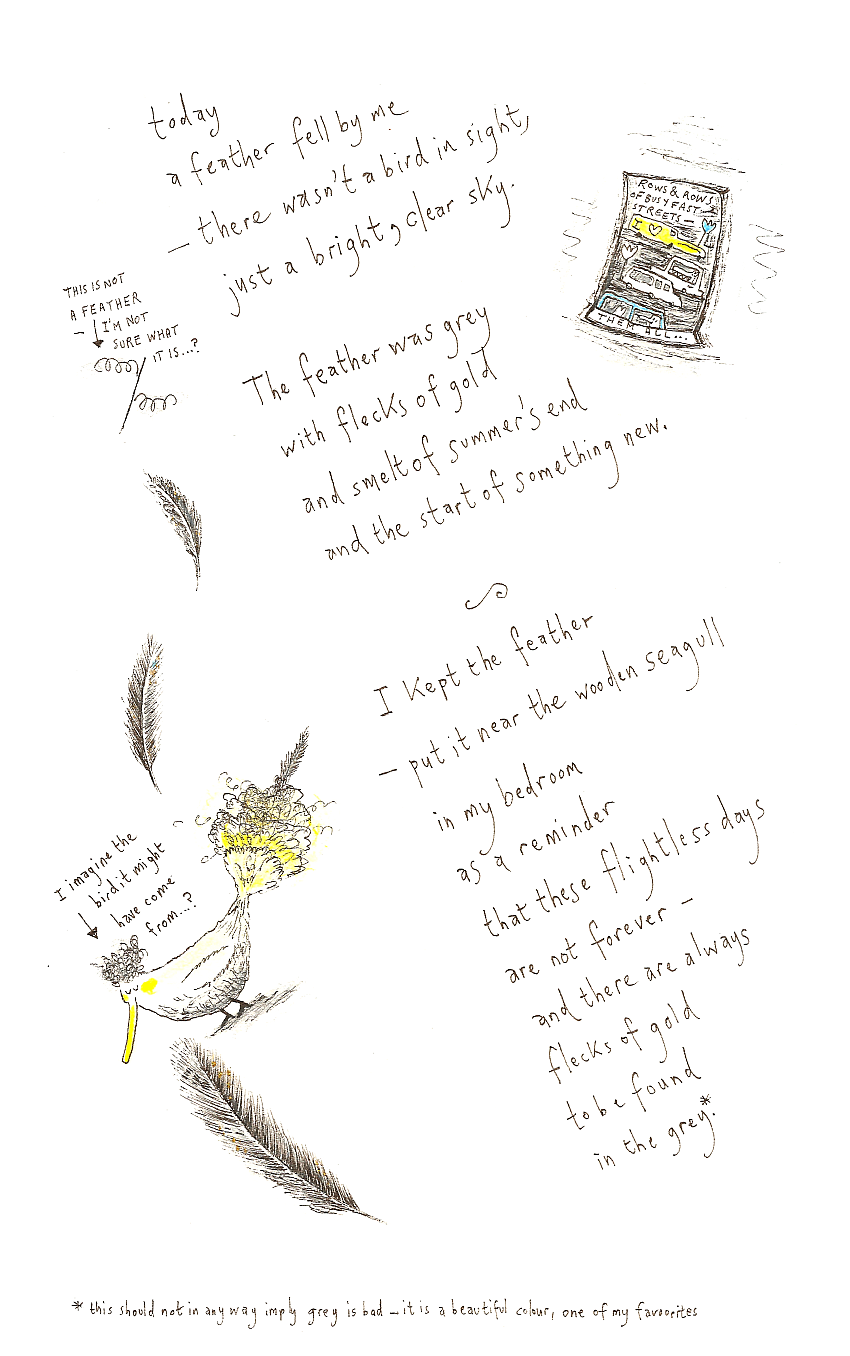
 Cole had a secret.. he could fly with the help of balloons. Where will he go? What will he see? Adventures lay beyond his little street. This is my submission for IF.. haven't participated in a loooong time. I'm working on the painting now and hopefully will be finished before Friday! Happy Illustrating!
Cole had a secret.. he could fly with the help of balloons. Where will he go? What will he see? Adventures lay beyond his little street. This is my submission for IF.. haven't participated in a loooong time. I'm working on the painting now and hopefully will be finished before Friday! Happy Illustrating!
An Illustration Friday submission for the word “return”. Duck is all nice and tanned from his stay in the sunny south!
He looks a little high if you ask me. Hehehe!
Why are bunny feet and paws so cute?
very cute – like the little touches like the box that reads icarus inc
Linda, you never cease to amaze me or make me laugh. thanks for posting this sketch :)